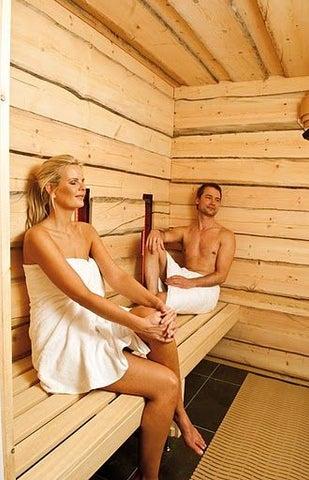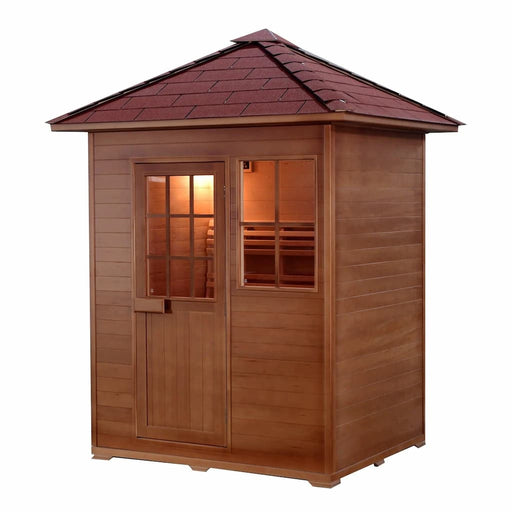Traditional Sauna Fundamentals Explained
Traditional Sauna Fundamentals Explained
Blog Article
An Unbiased View of Traditional Sauna
Table of ContentsHow Traditional Sauna can Save You Time, Stress, and Money.Some Known Details About Traditional Sauna Traditional Sauna - The FactsTop Guidelines Of Traditional Sauna
Many of the weight shed in a sauna is water loss and is re-gained upon rehydrating. Without an uncertainty sauna can be a crucial component of a healthy weight loss program. To look at the distinctions between typical and IR saunas, I will certainly separate these into verifiable, theoretical, and made distinctions.Therefore, the best point in the saunawhich is at the ceiling directly above the sauna heateris generally in between 185 and 190 F. Traditional Sauna. Claims that a standard sauna exceeds 200 F is simply not true and not relevant for electric saunas sold in the United States. The temperature for a far-infrared sauna is typically established between 120 and 140 F; nonetheless, unlike the traditional sauna, the goal in and IR space is not to attain a high temperature level
Due to this, the temperature level difference is nearly unimportant, given that excessive sweating leads to both sauna types, but the approach of heating the body is different. In an IR sauna the bather will certainly feel hot and will sweat profusely, yet at a lot reduced temperature levels. Hence, if the objective is to spend longer time periods in the sauna, the IR sauna is a good choice.

Traditional Sauna Can Be Fun For Everyone
When the high temperature level is achieved, the aspects cycle on and off to keep the high temperature. Most standard sauna individuals appreciate pouring water over the rocks to produce heavy steam to elevate sauna moisture levels. The benefits of pouring water over the rocks consist of: making the area a lot more comfortable, dampening the nasal flows, and enabling the use of aromatherapy by blending crucial oils with the water.
In a far-infrared sauna, the warm front pass through the body to effectively warm the body and raise the body core temperature. To attain this enhanced temperature, Far-infrared emitters produce infrared energy which is close to the exact same More Info wavelength as that which the body naturally emitsoften described as the "Essential Array" of 7 to 14 microns), so the power is well obtained by the body.
When the energy gets in the body, it creates the body temperature level to raise and ultimately causes perspiration. In an infrared sauna it is necessary for the emitters/heaters to continue to be on practically frequently. Since there is no mass of rocks to retain warm, the sauna will cool if the emitters shut down.
As stated above, the sauna bather in an infrared room intends to position himself in front my response of running emitters to obtain optimal gain from the warm. The heating time for both rooms can be really different, depending on exactly how the areas are used. For a conventional sauna, a bather needs to allow 30-40 minutes for the room to accomplish a wanted temperature and to appropriately pre-heat the rocks.
Traditional Sauna Can Be Fun For Everyone
A well built sauna will usually accomplish a temperature of 150-160 F in about 30-40 mins. For hotter temperatures, the space may require to warm for a longer period.
To some, 15 minutes was "lost" while the infrared power warmed the timber panels instead of warming a body, while others locate a pre-heated area to be a lot more comfy and think a raised beginning temperature is required to start sweating. The length of recommended usage for each area is roughly the very same (10-15 minutes per session); however, as a result of the lower air temperatures and the capacity to really feel the results of infrared heat faster than a standard sauna, it is not uncommon for an individual to invest a total amount of 20-30 minutes in an infrared sauna.
Standard saunas often tend to be larger (therefore utilize more electricity) than infrared saunas, although standard saunas are certainly readily available in visit our website one and 2 individual sizes. For a two-person traditional sauna, 5x6 or 5x7 dimension is most preferred. The top bench can conveniently seat 2 or 3 people and is also enough time to relax throughout the sauna session.


The ordinary expense per kWH of electrical energy in the U.S. is approximately $0.11, so a 4.5 kW heater will set you back approximately $.50 to compete one hour, if the heating system runs continually for one hour. Normally a sauna heater will certainly compete 75% of the initial hour and 50% of subsequent hours on since the aspects cycle once the established temperature level is attained.
The Ultimate Guide To Traditional Sauna
A 2 individual far-infrared room is normally physically smaller sized than a standard sauna, often about 4' x 4' or smaller sized. The IR heater is normally 1.5-1.7 kW utilizing a 120 volt 15 amp plug-in solution. Because the area can be used quicker than a sauna area, we will certainly assume the space is made use of for to of an hour including warm up time.
There is a rarely reviewed difference in the social experience in between the 2 rooms. While our culture has actually shed several of the social advantage of the typical sauna experience, it can be very socially gratifying. From family members time in the sauna, to heart-felt discussions with substantial others, to sauna partiesthe traditional sauna experience can result in intimate socializing.
Most greater end infrared areas include colored light therapy, sound systems and full-glass fronts.
Report this page